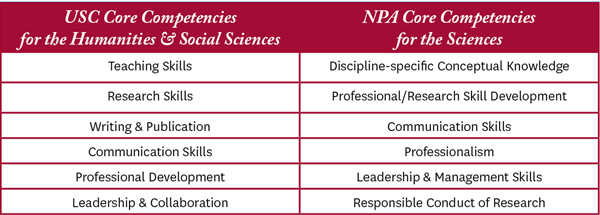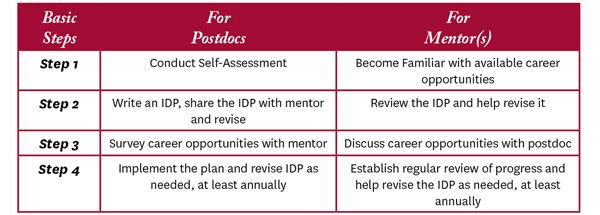The concept of an Individual Development Plan (IDP) for postdoctoral scholars was introduced by the Federation of American Societies for Experimental Biology (FASEB)’s Science Policy Committee and is fairly well established for postdoctoral scholars in the sciences. According to FASEB, the purpose of the IDP is to “provide a planning process that identifies both professional development needs and career objectives. Furthermore, IDPs serve as a communication tool between individuals and their mentors.”
At USC, we expect that postdoctoral scholars will be provided the opportunity to develop the following core competencies:

The IDP focuses on these core competencies and their development in line with the postdoc’s career aspirations. The IDP process, initiated by the postdoc with full participation by the mentor(s), consists of four steps for both postdoctoral scholar and mentor(s):

According to FASEB, these steps “are an interactive effort, and so both the postdoctoral fellow and the mentor must participate fully in the process”.
The IDP
The Self-assessment Form
The self-assessment form asks a number of questions based on discipline specific core competencies. The outcomes of the self-assessment will serve as the basis for the IDP form, which is to be shared with the mentor(s). A postdoc is expected to conduct a self-assessment and generate a draft IDP to share with their mentor(s) within the first month of arrival at USC, and on an annual cycle thereafter. The self-assessment form is most likely to be a private document that the mentor(s) should not expect to see.
The Self-assessment Forms
For postdoctoral scholars in the sciences, you can also use myIDP, a new Web-based career-planning tool created to assist postdocs in the sciences define and pursue their career goals.
The IDP Form
The IDP form should be shared in a draft form with the mentor(s) at the meeting where the postdoc’s accomplishments and goals will be discussed in light of the core competencies and the postdoc’s career aspirations. After the meeting, the postdoc will revise the form and present it to the mentor(s) for signature(s), which will serve to formalize the process and document the meeting outcomes.
The IDP Forms
For postdoctoral scholars in the sciences, you can also use myIDP, a new Web-based career-planning tool created to assist postdocs in the sciences define and pursue their career goals.
Meetings
Meetings between postdocs and their mentor(s) will probably occur frequently, both formally and informally. However, a formal meeting where the IDP is discussed and signed should occur at least once per year.
Resources
1. IDP from the Federation of American Societies of Experimental Biology (FASEB).
2. The National Postdoctoral Association (NPA)
3. University of Minnesota Office of Postdoctoral Affairs Postdoc IDP document.
4. USC Clinical and Translational Science Institute’s KL2 Mentored Research Career Development Program Informational Booklet 2012-2014